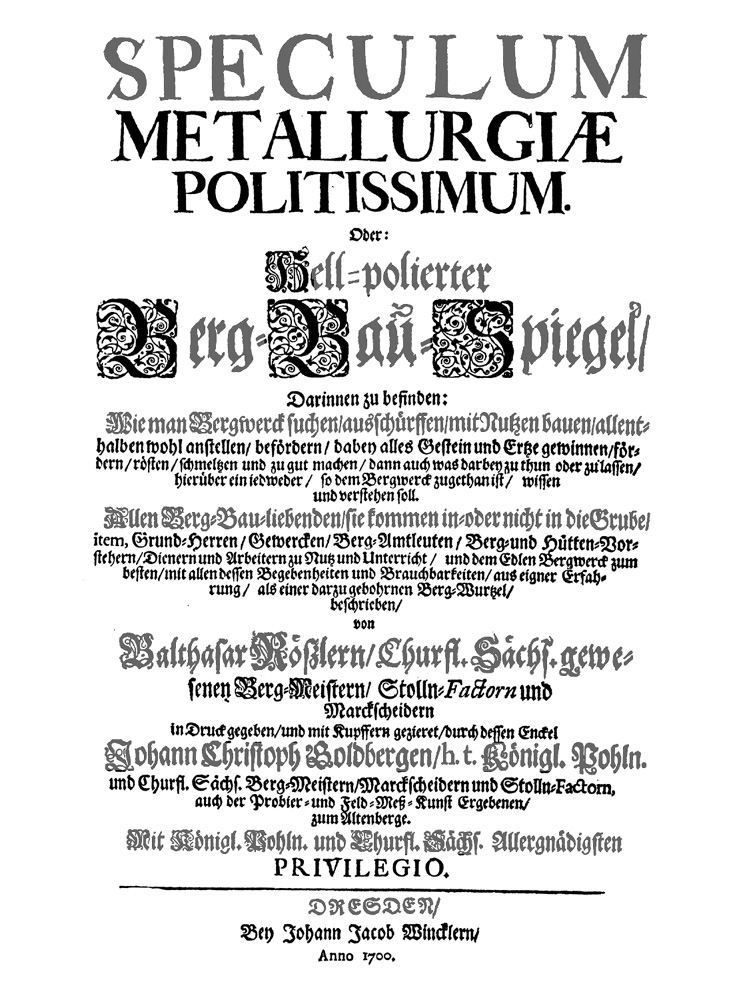ROESSLER, Balthasar.
(1606? – 1673)

1. German, 1700 [First edition].
[In red:] Speculum | [in black:] Metallurgiæ | Politissimum. | Oder: | [in red:] Hell=polierter | [the following line in red except for the initial letters:] Berg=Bau=Spiegel/ | [in black:] Darinnen zu befinden: | [in red:] Wie man Bergwerck suchen/ ausschürffen/ mit Nutzen bauen/ allent= | [in black:] halben wohl anstellen/ befördern/ dabey alles Gestein und Ertze gewinnen/ för= | dern/ rösten/ schmeltzen und zu gut machen/ dann auch was darybey zy thun oder zu lassen/ | hierüber ein iedweder/ so dem Bergwerck zugethan ist/ wissen | und verstehen soll. | [in red:] Allen Berg=Bau=liebenden/ sie kommen in=oder nicht in die Grube/ | [in black:] item, Grund=Herren/ Gewercken/ Berg=Amtleuten/ Berg= und Hütten=Vor= | stehern/ Dienern und Arbeitern zu Nutz und Unterricht/ und dem Edlen Bergwerck zum | besten/ mit allen dessen Begebenheiten und Brauchbarkeiten/ aus eigner Erfah= | rung/ als einer darzu gebohrnen Berg=Wurtzel/ | beschrieben/ | von | [in red:] Balthasar Röszlen/ Churfl. Sächs. gewe= | [...in black, 2 lines of titles and memberships...] | [in black:] in Druck gegeben/ und mit Kupffern gezieret/ durch dessen Enckel | [in red:] Johann Christoph Goldbergen/ h.t. Königl. Pohln. | [...in black, 3 lines of titles and memberships...] | [in red:] Mit Königl. Kohln. und Churfl. Sächs. Allergnädigsten | [in black:] Privilegio. | [rule] | [in red:] Dresden/ | [in black:] Bey Johann Jacob Wincklern/ | Anno 1700.
2°: [a]2 b-c2 A-2Z2 3a2 3A-3I2; 117l.; [12], 168, [54] p., 25 leaves of plates. Includes index. Title page in red and black with Schwabacher initials. Woodcut Schwabacher and vignette initials, vignette and historiated tailpieces; typographic head- and tailpieces. Text in gothic type, with occassional Roman; typographic tables. Page size: 288 x 206 mm.
Contents: [2 pgs], Half title page, "Speculum | Metallurgiæ | Politissimum," verso blank.; [2 pgs], Title page, verso "Efaia 60.v.17. | ..."; [4 pgs/=b1r-b2v], Dedication, signed Johann Christoph Boldberger, 3 May 1700.; [4 pgs/=c1r-c2v], "Vorrede."; [1]-168, Text.; [20 pgs/=Vv1r-Zz2v, aaa1rv], "Register/ derer vornehmster Sachsen/ ..."; [36 pgs/=Aaa1r-Iii2v], Deutsche erklärete | Bergmännische Termini und Redens=Arten/ | ..."
Very rare. Edited by Johann Christoph Goldberg, the author's grandson, this is the first edition of an important and finely illustrated pioneering work on mining and metallurgy, which is also important in the development of geological science. "A rare work on mining and metallurgy in Saxony at the end of the seventeenth century" (Honeyman). Rössler presented the idea that mineralized veins were the result of infilling of open fissures and this directed attento to the significance of crystal druses (incrustations of small crystals) in the vein.
The preliminaries feature dedications to the patrons: Wolff Dietrich von Beuchlingen, Abraham von Schoenberg, Hanns Larln von Carlowitz, and Johann Aegidio Alemannen, all high officials in the Saxon government. A dedicatory letter to these patrons from the editor and an introduction detailing the history of mining literature. In the foreword the editor states his great debt to Agricola, Ercker, Löhneyss and Becher. The text then begins with sections on earth, minerals, mountains, and surface soil conditions, this volume describes and illustrates the full spectrum of practical aspects concerning 17th century mining and metallurgy, from surveying and finding lodes to digging and fortifying mines with timber to extraction and processing of metals, with detailed instructions for the various processes. A number of tables provide extensive information on smelting techniques and processes. Roessler also included a section on the use of divining rods, suggesting that the user's own capacity affects the rod's results.Divining rods figure prominently in one of the engravings, which shows surveyors overseeing four workers, three of whom are following the path of their dowsers while the other marks the lines. Twenty-five charmingly amateurish, though technologically astute, copper engravings by Roessler's grandson, Johann Christoph Goldberg, who also served as Roessler's posthumous editor for this work, illustrate various surveying, mine engineering, mining, smelting, and refining techniques, as well as depicting various lode formations. An index, a list for the binder of the engravings and their locations, and a large glossary of mining terminology follow the text.
This is the only published work by Roessler, a mining expert and surveyor in the prince of Saxony's service, and the inventor of a suspended mining compass in 1633.The plates are numbered but not in the order in which they are to be inserted in the text. At the end of the LC copy is leaf (unpaged, unsigned; not included in page count) with plate placement instructions.
Facsimile reprints, 1978 & 1980: This work was published in facsimile in Prague in 1978 by Narodni Techniske Muzeum, and in Leipzig in 1980 by Deutscher Verlag fur Grundstoffindustrie.
Bibliographical references: Adams, Birth and Development, 1938: p. 310. • Agricola Bibliographie: ??. • Darmstädter, Berg-Büchlein, 1926: p. ??. • Ferchl: p. 450. • Honeyman Sale: VI.2673. • Hoover Collection: no. 688.
.